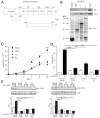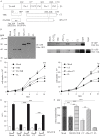Identification of two regions in the p140Cap adaptor protein that retain the ability to suppress tumor cell properties
- PMID: 23841028
- PMCID: PMC3696535
Identification of two regions in the p140Cap adaptor protein that retain the ability to suppress tumor cell properties
Abstract
p140Cap is an adaptor protein that negatively controls tumor cell properties, by inhibiting in vivo tumor growth and metastasis formation. Our previous data demonstrated that p140Cap interferes with tumor growth and impairs invasive properties of cancer cells inactivating signaling pathways, such as the tyrosine kinase Src or E-cadherin/EGFR cross-talk. In breast cancer p140Cap expression inversely correlates with tumor malignancy. p140Cap is composed of several conserved domains that mediate association with specific partners. Here we focus our attention on two domains of p140Cap, the TER (Tyrosine Enriched Region) which includes several tyrosine residues, and the CT (Carboxy Terminal) which contains a proline rich sequence, involved in binding to SH2 and SH3 domains, respectively. By generating stable cell lines expressing these two proteins, we demonstrate that both TER and CT domains maintain the ability to associate the C-terminal Src kinase (Csk) and Src, to inhibit Src activation and Focal adhesion kinase (Fak) phosphorylation, and to impair in vitro and in vivo tumor cell features. In particular expression of TER and CT proteins in cancer cells inhibits in vitro and in vivo growth and directional migration at a similar extent of the full length p140Cap protein. Moreover, by selective point mutations and deletion we show that the ability of the modules to act as negative regulators of cell migration and proliferation mainly resides on the two tyrosines (Y) inserted in the EPLYA and EGLYA sequences in the TER module and in the second proline-rich stretch contained in the CT protein. Gene signature of cells expressing p140Cap, TER or CT lead to the identification of a common pattern of 105 down-regulated and 128 up-regulated genes, suggesting that the three proteins can act through shared pathways. Overall, this work highlights that the TER and CT regions of p140Cap can efficiently suppress tumor cell properties, opening the perspective that short, defined p140Cap regions can have therapeutic effects.
Keywords: Csk; Src; breast cancer; cell signaling; colon cancer; lung cancer; p140Cap.
Figures




References
-
- Cabodi S, del Pilar Camacho-Leal M, Di Stefano P, Defilippi P. Integrin signalling adaptors: not only figurants in the cancer story. Nat Rev Cancer. 2010;10:858–870. - PubMed
-
- Damiano L, Di Stefano P, Camacho Leal MP, Barba M, Mainiero F, Cabodi S, Tordella L, Sapino A, Castellano I, Canel M, Frame M, Turco E, Defilippi P. p140Cap dual regulation of E-cadherin/EGFR cross-talk and Ras signalling in tumour cell scatter and proliferation. Oncogene. 2010;29:3677–3690. - PubMed
-
- Chin LS, Nugent RD, Raynor MC, Vavalle JP, Li L. SNIP, a novel SNAP-25-interacting protein implicated in regulated exocytosis. J Biol Chem. 2000;275:1191–1200. - PubMed
LinkOut - more resources
Full Text Sources
Research Materials
Miscellaneous
